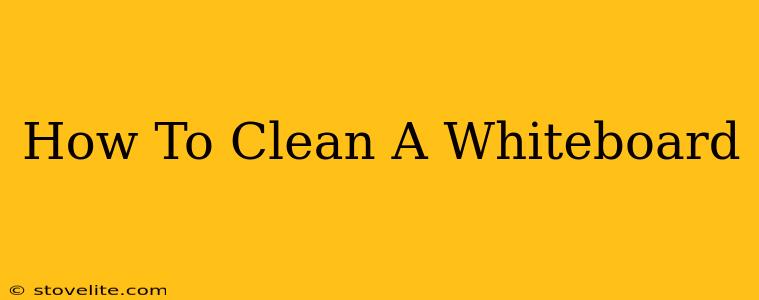Whiteboards are essential tools in offices, classrooms, and homes. Keeping them clean ensures readability and extends their lifespan. But knowing the best way to clean a whiteboard can be tricky. This guide will walk you through effective cleaning methods, covering different types of marks and preventing future stains.
Understanding Your Whiteboard Surface
Before diving into cleaning, it's important to understand your whiteboard's material. Most are either porcelain steel or melamine. While cleaning methods are generally similar, being aware of the material helps you choose the gentlest approach. Aggressive cleaning can damage the surface, leading to scratching or ghosting (faint, persistent marks).
Common Whiteboard Stains and How to Tackle Them
Different stains require different approaches. Here's a breakdown:
-
Dry Erase Markers: These are the most common culprits. A simple, slightly damp cloth is usually sufficient. For stubborn marks, try a slightly stronger solution (see below).
-
Permanent Markers: These are tougher. Isopropyl alcohol (rubbing alcohol) is often effective, but always test it on an inconspicuous area first to ensure it doesn't damage the surface.
-
Grease or Oil: These leave greasy smudges. Use a mild dish soap solution with a soft cloth. Rinse thoroughly with clean water and dry.
-
Ghosting: This refers to faint marks that won't erase. Often, this is due to residue buildup. A deeper clean (see below) is needed.
The Best Ways to Clean Your Whiteboard
Here are some effective cleaning methods for tackling various whiteboard challenges:
Method 1: The Basic Clean
This is your go-to method for daily maintenance:
- Gather your supplies: A soft, lint-free cloth (microfiber is ideal), warm water.
- Dampen the cloth: Slightly dampen the cloth; don't soak it. Excess water can damage the board.
- Wipe the surface: Gently wipe the whiteboard from top to bottom, using even strokes.
- Dry the surface: Use a clean, dry cloth to wipe away any remaining moisture.
Method 2: Tackling Stubborn Marks
For more persistent stains:
- Create a cleaning solution: Mix a small amount of mild dish soap with warm water.
- Apply the solution: Dampen the cloth with the solution and gently wipe the affected areas.
- Rinse thoroughly: Use a clean, damp cloth to rinse away the soap residue.
- Dry completely: Wipe the whiteboard dry with a clean, dry cloth.
Method 3: Deep Cleaning for Ghosting
If you're dealing with ghosting:
- Use a glass cleaner (carefully!): Spray a small amount of glass cleaner onto a clean cloth (not directly onto the board). Test on an inconspicuous area first.
- Wipe gently: Wipe the entire surface gently, paying extra attention to ghosting areas.
- Rinse thoroughly: Use a clean, damp cloth to remove all traces of the cleaner.
- Dry completely: Ensure the board is completely dry before use.
Important Note: Never use abrasive cleaners, scouring pads, or bleach on your whiteboard. These can permanently damage the surface.
Preventing Whiteboard Stains: Tips and Tricks
Preventing stains is easier than removing them. Here are some helpful tips:
- Use high-quality dry-erase markers: Cheap markers often leave behind more residue.
- Always cap your markers: This prevents them from drying out and becoming harder to erase.
- Clean regularly: Daily wiping with a damp cloth prevents buildup.
- Avoid using permanent markers: If you must, use a specialized whiteboard marker designed for permanent use.
By following these simple steps, you can keep your whiteboard clean, functional, and looking its best for years to come. Remember to always test any cleaning solution on a small, inconspicuous area before applying it to the entire surface. Happy cleaning!

